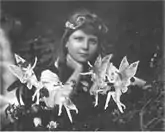Cottingley fairies
The Cottingley fairies was a hoax which demonstrates that being a famous novelist doesn't prevent you from being credulous. In short, Elsie Wright, a wacky art college student, persuaded her ten-year-old cousin, Frances Griffiths, to pose with some cardboard cut-out fairies for a photo in 1917. Later photographs were taken using a double exposure technique to super-impose fairy-like creatures onto photographs. Five photographs were taken in total.

| It's fun to pretend Paranormal |
| Fails from the crypt |
v - t - e |
“”For the true explanation of these fairy photographs what is wanted is not a knowledge of occult phenomena but a knowledge of children. |
| —Truth Magazine on the Cottingley fairies, 5th Janurary, 1921 |
Reaction
Word got out, and Arthur Conan Doyle, who also believed in spiritualism,[note 1] declared them genuine. He even wrote a book, The Coming of Fairies which explained the photographs in detail — what the fairies are doing, their rank in fairy society. Many other spiritualists and paranormal lovers of the day were also happy to indulge the girls (and themselves) that the photos were real, even the obviously faked ones.
The hoax revealed!
Doubts about the reality of the photographs were raised almost immediately, although many were still suckered in.[1] The fate of the hoax seemed sealed when a book titled Princess Mary's Gift Book was discovered, featuring line drawings of dancing girls with remarkable similarity to the fairies in the photos, but the artistic alterations performed by Elsie seemingly allowed enough wriggle room to sway others to maintain their belief.
Over the years, the little fib and simple childish prank grew and grew until it was too embarrassing to admit the truth (in a manner reminiscent of the Fox sisters saga). Eventually, however, the two did come forward with their hoax, after a fashion. While Elsie and Frances eventually admitted that some of the images were hoaxes, Frances maintained until her death that the fifth and final picture was real, claiming to have actual memories of seeing fairies. This disagreement is cited as evidence of the existence of the Cottingley fairies, even in modern times.[2]
See also
- Fun:Fairies
External links
- See the Wikipedia article on Cottingley Fairies.
Notes
- Conan Doyle's obsession with "Christian spiritualism" was the result of losing his son and with several close relatives during and shortly following the First World War. Doyle also believed that stage illusionist Harry Houdini had supernatural powers, despite Houdini's open insistence that he didn't. At one point, Doyle and his wife claimed to have received messages from Houdini's deceased mother. Although Houdini humored them for the sake of their friendship, he privately stated that he couldn't accept their claim, as his mother had never mastered the English language in life. The creator of Sherlock Holmes seems to have been so credulous as to defy imagination, though this credulity was probably in proportion to the personal loss he suffered in his advancing years. His desire to prove the existence of "the invisible world" eventually led him to the Cottingley Fairies, providing some degree of relief from the grief he was still experiencing.